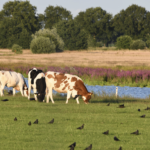(First published on August 28, 2017)
By Benjamin Richardson
(Professor of Environmental Law, University of Tasmania; Tilburg University’s Global Law Visiting Chair 2017)
(Photo: Blue Marble, 7 December 1972, NASA Apollo 17 mission)
Among the most reproduced photographs in the world are NASA’s first images of Earth — most famously the iconic Blue Marble image taken by the Apollo 17 crew in 1972 from a distance of 45,000 km from the planet’s surface. It profoundly moved people with a stunning picture of a beautiful yet vulnerable planet, and helped propel the global environmental movement.[1]
Aesthetics can touch our most visceral feelings about the natural environment in ways that technical data or expert reasoning cannot easily conjure. Majestic scenery, charismatic animals, and serene landscapes are among the perceived glories of natural environments that motivate people to care for them. An Italian and German may not understand one another’s tongue but can share admiration of a sublime mountain range or exquisite bird of paradise. Such affection can translate into stronger legal status for such places and species, such as creation of a national park or protection of treasured wildlife. In Tasmania, where I live, nature’s beauty of this genre is never far away.
Aesthetic values have ostensibly informed numerous environmental laws. Great Britain’s National Parks and Access to the Countryside Act 1949 was established ‘for the purpose of preserving and enhancing the natural beauty’ (section 5(1)). The goals of the United States’ National Environmental Policy Act 1969 include ensuring ‘esthetically and culturally pleasing surroundings’ and preserving ‘important historic, cultural, and natural aspects of our national heritage’ (42 U.S. Code s. 4331). Internationally, the World Heritage Convention of 1972 safeguards ‘natural areas of outstanding universal value from the point of view of … natural beauty’ (article 2). In domains inhabited by people, municipal land-use planning commonly incorporates aesthetic criteria to protect architectural gems, historic streetscapes and bucolic countryside.
But we should not infer that aesthetic values are environmental law’s leitmotif – indeed quite the contrary. Scientific knowledge and economic values dominate rationalisations for environmental decisions. Arguments over how to deal with climate change or save endangered species are typically rationalised around the scientific evidence or economic costs and benefits. These criteria supposedly inject ‘objectivity’ and ‘neutrality’ into often deeply politicised disputes over the environmental impacts of developments. Public participation is another valorised input into environmental governance, as endorsed in most legislation and the Aarhus Convention; however, citizen participation (which can be a means to express aesthetic values) in practice is often managed for appearances in order to secure public acceptance of decisions already reached on other grounds.[2]
Is aesthetics thus only to hold a minor place in environmental governance, and what issues must we address in defining its role? I believe that beauty and other aesthetic values should have a more prominent place here. While science and economics supply a variety of reasons to conserve nature, such as revealing its biodiversity values or economic benefits, these disciplines do poorly in emotionally engaging people with their environs. Abundant environmental science has struggled to leverage fundamental shifts to our environmental attitudes and practices, as evident in continuing deforestation, industrial development and pollution. A sense of place or other personal connection to an environment grows when its beauty, spirituality or other sensuous qualities uplifts one. Empirical research shows positive correlations between specific landscape or environmental features and human wellbeing.[3] And individual well-being can lead to social change: as Aldo Leopold presciently observed, ‘we can only be ethical in relation to something we can see, feel, understand, love, or otherwise have faith in’.[4]
Finding beauty in nature’s small stuff: Mycena interrupta, Blue Mountain View, Tasmania (photo: B. Richardson).
But any appeal to enrich legal governance with environmental aesthetics faces several challenges. Firstly, the aesthetic values that tend to captivate us are frequently associated with ‘specialness’ – perhaps a rare species or sublime landscape. But the ‘specialness’ benchmark has drawbacks: we should protect species before they become so endangered or rare as to move us, and pretty landscapes are not necessarily more ecologically important than a ‘mundane’ grassland or swamp. Even human-dominated landscapes punctuated by billboards and buildings, or golf courses and garbage dumps, can harbour wildlife adapted to living in our midst.[5] If we are to leverage action through environmental aesthetics, we must find beauty or other aesthetic values more widely than just within ‘special’ enclaves.
Secondly, because of the common assumption that the human response to aesthetics is subjective rather than factual or rational, aesthetic judgements determined by the beholder rather than the object can be viewed as deficient. Colloquially, we typically call this bias ‘beauty being in the eye of beholder’. Some researchers identify a shared, cross-cultural preference for landscapes that resemble Homo sapiens’ evolutionary cradle, the undulating African savannah.[6] Psychologists also identify a shared taste for fractal patterns in scenery, ‘featuring patterns that repeat at increasingly fine magnifications’ such as clouds, rivers and coastlines.[7] But while an aesthetic sense is surely a universal human trait, it is both personality- and culture-bound, with different artistic expressions and preferences found between and within cultures: a lover of Van Gogh’s delicate Irises might easily spurn Mark Rothko’s austere No.61 (Rust and Blue).
Trashing nature’s beauty: somewhere in Tasmania (photo: B. Richardson).
Furthermore, in our urban demography we often aesthetically engage with nature not directly but vicariously — through David Attenborough-narrated films, lavish coffee-table books or soothing nature sounds CDs. Artistic representations of landscapes, flora and fauna are among humankind’s earliest cultural expressions, such as the 20,000 years old Palaeolithic paintings adorning the Lascaux Caves in France and Aboriginal rock art in Australia of even older vintage. The arts thus mediate our access to environmental aesthetics. Natural beauty has become an essential ‘resource’ for activist organisations. In Tasmania, it was especially evident in Olegas Truchanas’ and Peter Dombrovskis’ sublime photographs to rally public interest in saving Lake Pedder and the Franklin River respectively from dams, [8] and again today to help conserve the imperilled Tarkine rainforests through the ‘Tarkine in Motion’ festival.[9] While these examples tend to reinforce that ‘specialness’ bias, the arts are increasingly enlisted to conserve ‘ordinary’ nature; recent successful examples include the Tasmanian Land Conservancy’s ‘Poets and Painters’ (2016-17) and ‘Skullbone Experiment’ (2014) that engaged artists to educate the public about the ecological and aesthetic values of two of the Conservancy’s private reserves in relatively unimposing (but ecologically valuable) landscapes.[10]
Further challenges with environmental arts include that they sometimes cater to an unrepresentative socio-economic demography (ie, urban, affluent, educated), thus missing the rural and poorer communities who often have more at stake directly in the environmental controversies. And some people might ‘read’ landscapes not for their beauty but for other aesthetic values such as having a spiritual connection, as in Aboriginal Dreamtime stories. Going beyond the ‘purview of the “landscape” of other received aesthetic categories of environmental perception’, Alan Braddock recommends an ‘eco-critical’ approach that emphasizes ‘environmental inter-connectedness, sustainability, and justice in cultural interpretation’ and reexamining canonical works to highlight ‘neglected evidence of past ecological and proto-ecological sensibility’.[11] In other words, more diverse conceptions of environmental aesthetics can help address lacunae or biases, and respect art historian Simon Schama’s advice to recognise that landscapes have a socialised, layered history.[12]
Strengthening community involvement in environmental art might attenuate some of the foregoing challenges. Here the emphasis shifts from the artistic representation of the natural world as an object of admiration to community engagement and dialogue with that world. This approach not only dovetails with the theory of ‘interested engagement’ in the aesthetics literature,[13] but also environmental law’s commitment to public participation.[14] Ecological restoration projects provide an interesting setting for these goals, as currently practised by Greening Australia in its Tasmania Island Ark initiative. Greening Australia has collaborated with the University of Tasmania’s College of the Arts to involve artists with regional schools and local townships in designing sculptures for placement in the landscape not only to support the community’s interpretation of the restored biodiversity but also to directly aid the biodiversity’s recovery by designing artworks that serve as ‘species hotels’ for birds, bats and other creatures.[15] Another approach, used in the United States, was undertaken by the US Nature Conservancy in its restoration of a wetland in Illinois; it recruited citizens to be artists themselves — to draw, paint, photograph, or otherwise depict the restoration endeavour and its results.[16]
Beauty is indispensable for our relationships with the natural environment and the laws we design to conserve it, helping people to move beyond a cold, instrumental relationship to one provoking affinity, curiosity, adoration and other intimacies. Artistic depictions of landscapes can influence their legal status, as Alice Palmer has investigated in her excellent analysis of the impact of aesthetics in World Heritage property listings including those in my own homeland of Tasmania where Peter Dombrovskis’ photographs of its southwest wilderness were used by the Australian government as evidence to support its nomination of this area for World Heritage status.[17] Given the ineffectiveness of much environmental regulation and considerable insouciance by some about the Anthropocene, we need to re-think how to engage everyone in caring for the Earth and the legal means to leverage that engagement.
[1] R. Kelsey, ‘Reverse shot: Earthrise and Blue Marble in the American imagination’ in E.H. Jazairy (ed), Scales of the Earth (Harvard University Press, 2011), 10.
[2] S. Bedder, ‘Public participation or public relations?’ in B. Martin (ed), Technology and Public Participation(University of Wollongong, 1999), 169.
[3] R. Kaplan, ‘The nature of the view from home’ Environment and Behavior 33(4) (2001): 507; K. Williams and D, Harvey, ‘Transcendent experience in forest environments’ Journal of Environmental Psychology (2001) 21: 249.
[4] A. Leopold, A Sand County Almanac (Oxford University Press, 1949), xxvi.
[5] T. Low, The New Nature (Penguin, 2017).
[6] D. Dutton, The Art Instinct. Beauty, Pleasure, and Human Evolution (Bloomsbury Publishing, 2010), passim; J. Appleton, The Experience of Landscape (Wiley, 1975), 73-74.
[7] R. Taylor, ‘Fractal patterns in nature and art are aesthetically pleasing and stress-reducing’, The Conversation, 31 March 2017.
[8] T. Bonyhady, ‘No dams: the art of Olegas Truchanas and Peter Dombrovskis’, in R. Butler (ed), The Europeans: E´migre´ Artists in Australia 1930 – 1960 (National Gallery of Australia, 1990): 236.
[9] ‘Artists return from threatened Tarkine wilderness – major exhibition installed in Hobart’, Media release, Bob Brown Foundation, 2017.
[10] J. Deeth, ‘The Skullbone experiment: a paradigm of art and nature’, Artlink, June 2014; H. Aird, ‘Poets and painters: new exhibition produces “extraordinary synergies”’, ABC News 28 July 2017.
[11] A.C. Braddock, ‘Ecocritical art history’ American Art (2009) 23(2): 24, 26.
[12] S. Schama, Landscape and Memory (Fontana Press, 1995).
[13] A. Berleant, Living in the Landscape: Toward an Aesthetics of Environment (University Press of Kansas, 1997).
[14] B.J. Richardson and J. Razzaque, ‘Public participation in environmental decision-making’ in B.J. Richardson and S. Wood (eds), Environmental Law for Sustainability (Hart Publishing: 2006)): 165.
[15] Greening Australia, ‘Building hotels for Tasmania’s unique species’.
[16] S.K. Allison, Ecological Restoration and Environmental Change: Renewing Damaged Ecosystems (Routledge, 2012), 188.
[17] A. Palmer, ‘Legal dimensions to valuing aesthetics in World Heritage decisions’ Social and Legal Studies (2017): 1 at 8, DOI: 10.1177/0964663917698859.class=WordSection2>



